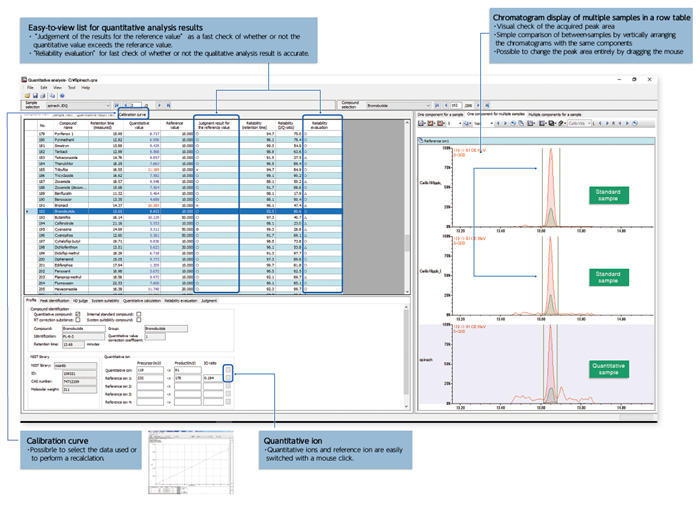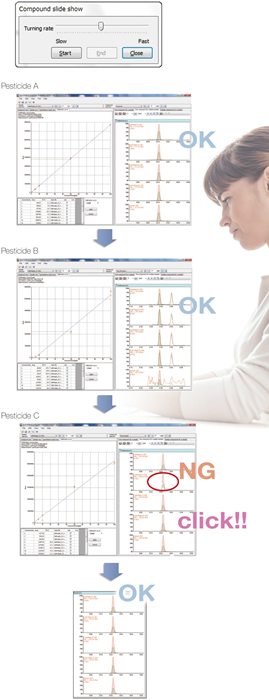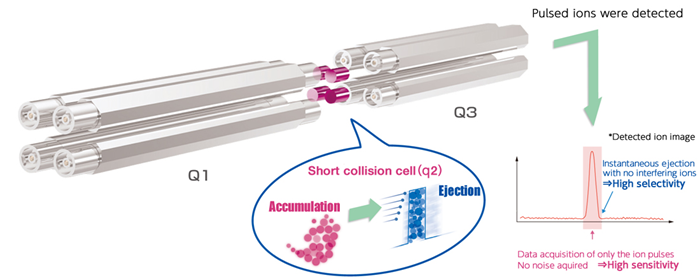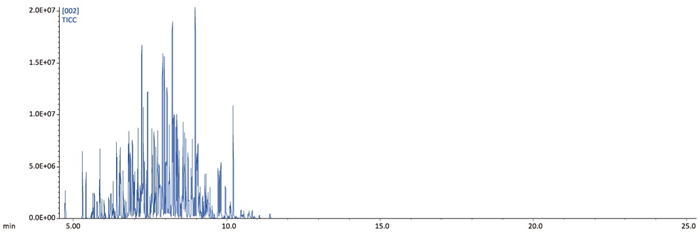Jeol's JMS-TQ4000GC Triple-Quadrupole Mass Spectrometer accurately detects trace or residual pesticides in agricultural products and trace quantities of controlled chemicals in tap water. It also simplifies the quantitative investigation of persistent environmental contaminants, including dioxins and PCBs.
The Triple Quad GC-MS/MS allows chemists to process large sample volumes quickly. It provides high sensitivity and precision for quantifying target compounds. With an SRM switching speed of 1,000 channels per second, the fastest in the industry, it can track multiple analytes efficiently. Speed and accuracy make it a powerful tool for high-throughput analytical workflows.
Fast and Accurate Quantitative Values
The JMS-TQ4000GC has three different technologies for high-speed analysis:
Short Cell and Ion Accumulation: The short collision cell collects ions and rapidly ejects them in pulses. Synchronizing pulsed ion ejection and signal capture reduces signal noise, allowing for high-sensitivity analysis.
Fast GC Technique: The TQ4000GC can expedite routine sample analysis. It reduces measurement time by using a capillary column with a small diameter and short length and a rapid oven temperature ramp.
Due to their narrow peak widths, fast-GC chromatograms require high-speed transitions. The TQ4000GC's short collision cell technology enables sufficiently high-speed transitions for fast-GC measurement without sacrificing sensitivity.
Easier and Faster Data Analysis
The TQ4000GC data analysis software, Escrime™, is user-friendly and designed for multi-component analysis. Chromatograms are organized in a vertical column, making it easy to compare samples, and Escrime™'s compound “slideshow” capability allows the chemist to confirm all samples and components present easily.
Wide Range of Organic Analyses
In addition to the standard electron ionization (EI) source, the JMS-TQ4000GC offers optional chemical ionization (CI) and photoionization (PI) sources, simplifying the determination of molecular weight information.
This system can extend beyond gas chromatography-mass spectrometry (GC-MS) with two optional direct probes available. The direct insertion probe for analyzing insoluble compounds and the direct exposure probe for high-boiling-point and thermally sensitive compounds.
Easy Maintenance
The ion source can be removed easily without tools for its routine maintenance, speeding up the process. The vacuum system features high pumping capacity, allowing users to restart analysis with minimal downtime.
Key Features
- A short collision cell offers increased sensitivity, higher throughput, and shorter acquisition times.
- The fastest SRM switching speed in the industry is 1000 transitions per second.
- Rapid pulsed ion ejection without crosstalk (ion interaction between SRM channels).
- EI (standard), CI, and PI (optional) sources.
- Easy to clean and maintain.
- Powerful and user-friendly software for data analysis and reporting.
- Direct Probes: Direct insertion probe (DIP) and direct exposure probe (DEP).
Easier and Faster Data Analysis
Data Analysis software for Multi-Target compounds "Escrime™"

Image Credit: JEOL USA, Inc.
- Jeol is committed to creating an easy-to-read interface and simple operation. Whilst conventional systems struggle to meet user needs, this user-friendly system easily meets consumer requirements.
- They have developed software to completely eliminate “pain points” during ordinary operation.
Slideshow for Data Check (Compound Slideshow Function)

Image Credit: JEOL USA, Inc.
- The slideshow function can be used to examine calibration curves for each pesticide component, as well as the single-column display of the chromatogram.
- Chromatograms and calibration curves that switch at a fixed timing can be visually checked.
- If a section needs correction, the slideshow can be paused and its peak reviewed.
Easy Maintenance
Easy to Clean Up the Ion Source and Quickly Resume Analysis

Image Credit: JEOL USA, Inc.
- There are no tools necessary to remove the ion source.
- The vacuum pump has a strong evacuation capability, making the time needed to recover measurements extremely low.
Key Technologies
Three Technologies provide Accurate Quantitative Values Faster
The user can get the highest sensitivity and high-speed measurement, thanks to the brief collision cell's capacity to accumulate ions and eject them in pulses. High-speed SRM switching, which is the quickest in the industry at 1,000 transitions/sec, can shorten measurement times. As a result, the user can increase throughput for comprehensive analysis.
Technology 1 – Ion Accumulation
The short collision cell collects ions and produces a pulse. Data is only recorded when an ion pulse occurs, not when there is merely noise, resulting in a much improved signal-to-noise ratio. This cell provides unprecedented high sensitivity and reproducibility.
Technology 2 – Short Cell

Image Credit: JEOL USA, Inc.
Using a short collision cell allows users to instantly eject all of the ions within the cell. This, along with the industry's fastest SRM, delivers great selectivity by eliminating interfering ions.
Technology 3 – Fast GC
Shorter measurement periods are made possible using short capillary columns with a small diameter and by rapidly changing the temperature of the GC oven. This considerably increases the number of samples that can be processed per hour. High-speed transitions are necessary because of narrow peak widths in the chromatogram, highlighting the short collision cell's capabilities.

Image Credit: JEOL USA, Inc.
Conventional GC-MS measurement
- Column:
- 30 m length
- 0.25 mm I.D.
- 0.25 μm film thickness
- Total 40 min

Image Credit: JEOL USA, Inc.
Fast GC-MS measurement
- Column:
- 20 m length
- 0.18 mm I.D.
- 0.18 μm film thickness
- Total 15 min
Videos
106703
Watch our expert, Chip Cody, introduce the new JMS-TQ4000GC Triple-Quadrupole Mass Spectrometer at the 2019 Pittcon Conference in Philadelphia. Video Credit: JEOL USA.